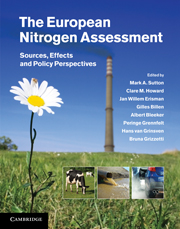Book contents
- Frontmatter
- Contents
- List of contributors
- Foreword
- Summary for policy makers
- Technical summary
- 1 Assessing our nitrogen inheritance
- Part I Nitrogen in Europe: the present position
- Part II Nitrogen processing in the biosphere
- Part III Nitrogen flows and fate at multiple spatial scales
- Part IV Managing nitrogen in relation to key societal threats
- Part V European nitrogen policies and future challenges
- 22 Costs and benefits of nitrogen in the environment
- 23 Developing integrated approaches to nitrogen management
- 24 Future scenarios of nitrogen in Europe
- 25 Coordinating European nitrogen policies between international conventions and intergovernmental organizations
- 26 Societal choice and communicating the European nitrogen challenge
- Glossary
- Index
- References
26 - Societal choice and communicating the European nitrogen challenge
from Part V - European nitrogen policies and future challenges
Published online by Cambridge University Press: 16 May 2011
- Frontmatter
- Contents
- List of contributors
- Foreword
- Summary for policy makers
- Technical summary
- 1 Assessing our nitrogen inheritance
- Part I Nitrogen in Europe: the present position
- Part II Nitrogen processing in the biosphere
- Part III Nitrogen flows and fate at multiple spatial scales
- Part IV Managing nitrogen in relation to key societal threats
- Part V European nitrogen policies and future challenges
- 22 Costs and benefits of nitrogen in the environment
- 23 Developing integrated approaches to nitrogen management
- 24 Future scenarios of nitrogen in Europe
- 25 Coordinating European nitrogen policies between international conventions and intergovernmental organizations
- 26 Societal choice and communicating the European nitrogen challenge
- Glossary
- Index
- References
Summary
Executive summary
Nature of the problem
Increased public and institutional awareness of both the benefits and threats of nitrogen has the potential to greatly increase the efficacy of nitrogen policy.
Insufficient recognition of the financial, behavioural and cultural barriers to achieving an optimal nitrogen future risks policy antagonisms and failure.
Here we examine some of the key societal levers for and barriers to achieving an optimal nitrogen future in Europe, drawing lessons from the more-developed societal and policy challenge of climate change mitigation.
Key findings/state of knowledge
There is currently a very low level of public and media awareness of nitrogen impacts and policies. However, awareness is high regarding the threats and benefits of ‘carbon’ to society (e.g. energy use and enhanced climate change).
Many national climate change mitigation policies now overtly recognize the importance of societal choice, and are increasingly utilizing behavioural change strategies to achieve greenhouse gas emission reduction targets.
In achieving an optimal nitrogen future, lessons can and should be learned from existing climate change-focused communication and behavioural science (e.g. use of a ‘segmented strategy’ to reach disparate groups of stakeholders).
Key sectors where societal choice has the potential to greatly influence nitrogen use efficiency include food production, consumption and waste.
- Type
- Chapter
- Information
- The European Nitrogen AssessmentSources, Effects and Policy Perspectives, pp. 585 - 601Publisher: Cambridge University PressPrint publication year: 2011
References
- 4
- Cited by

